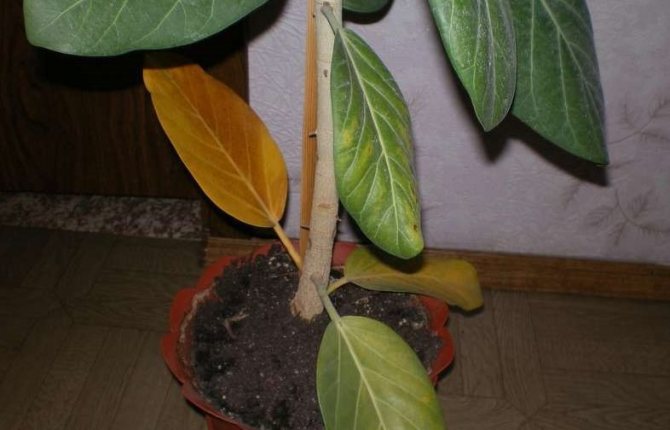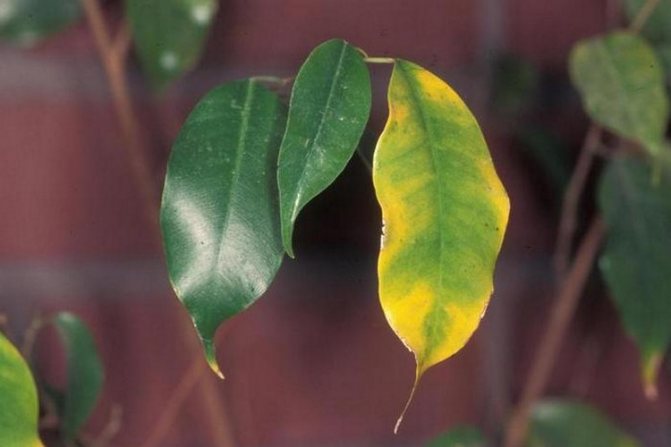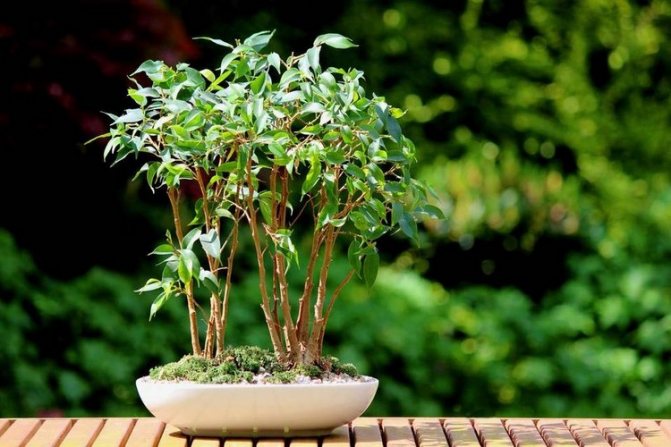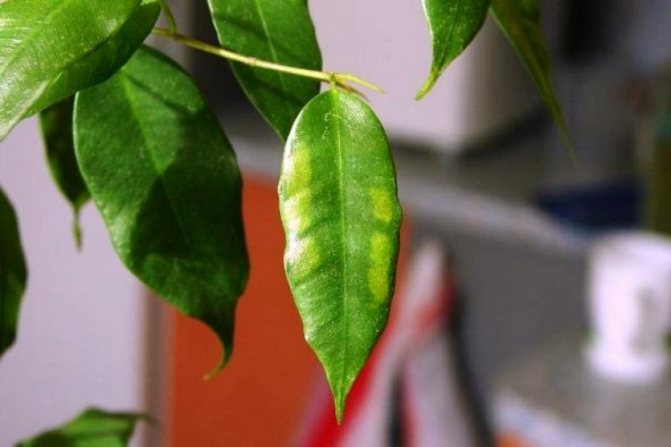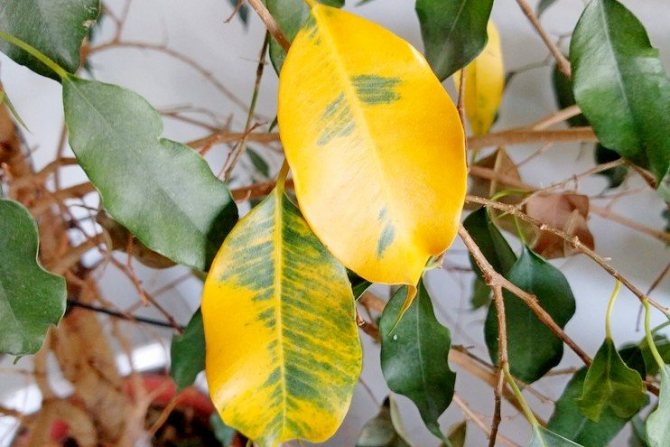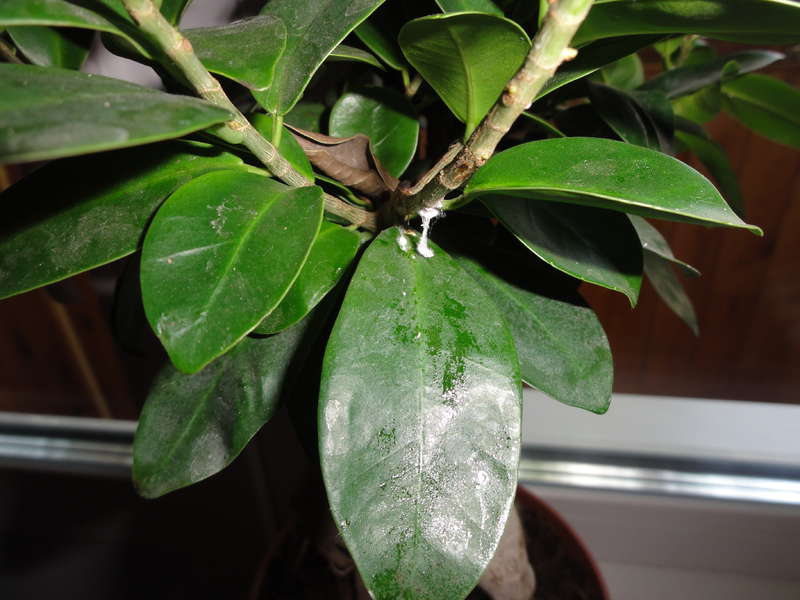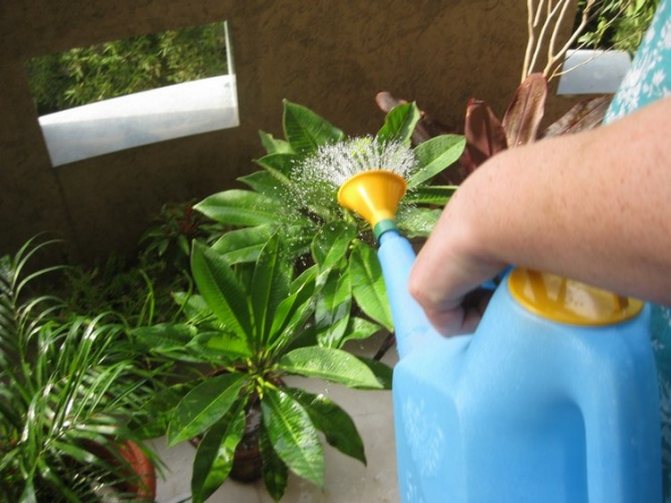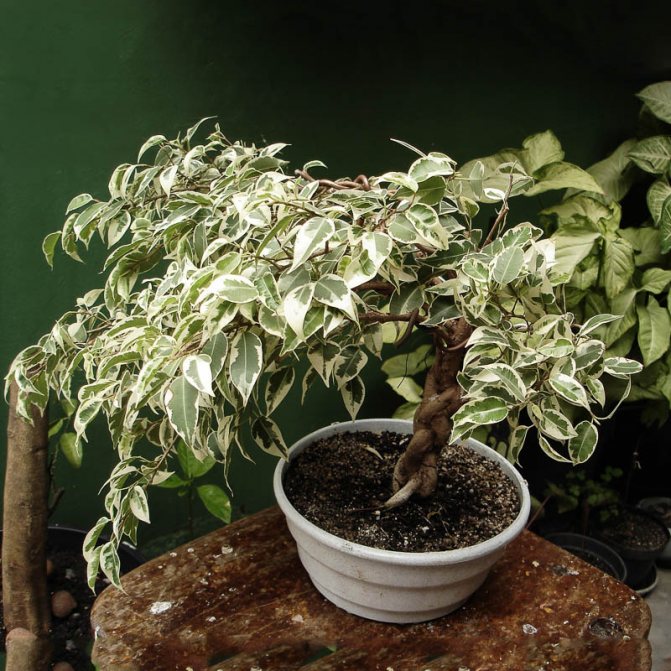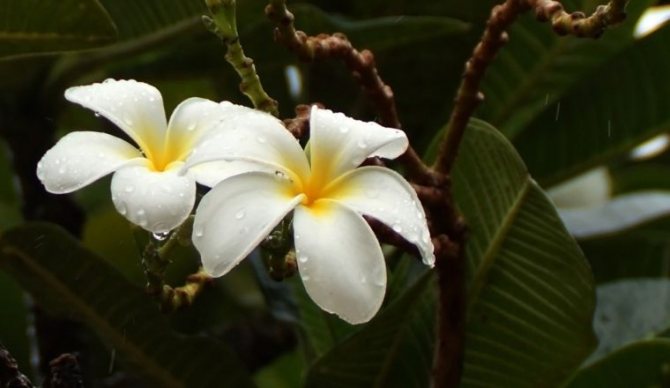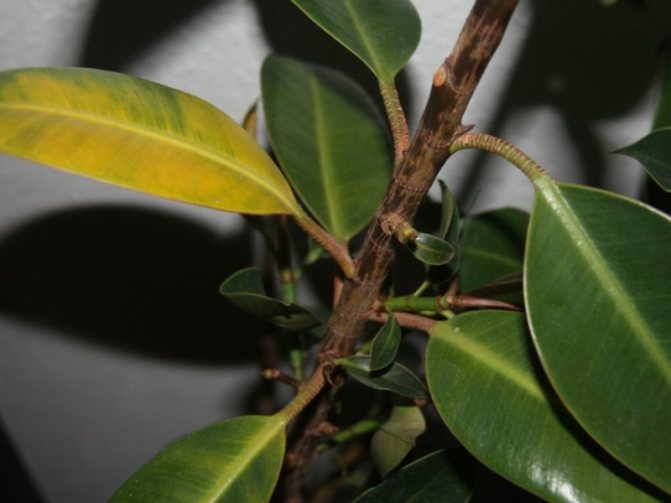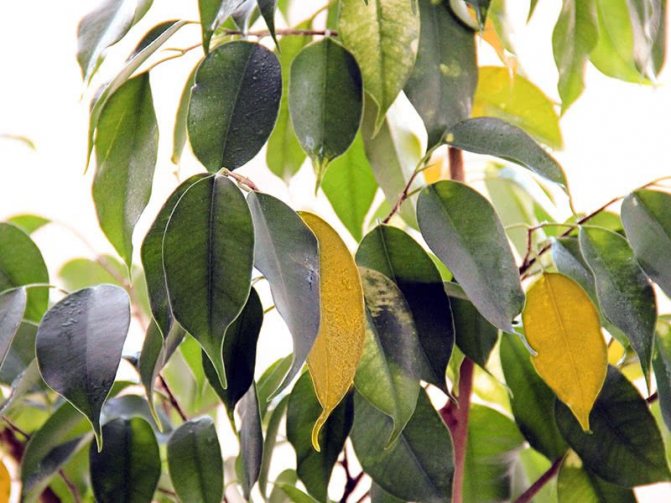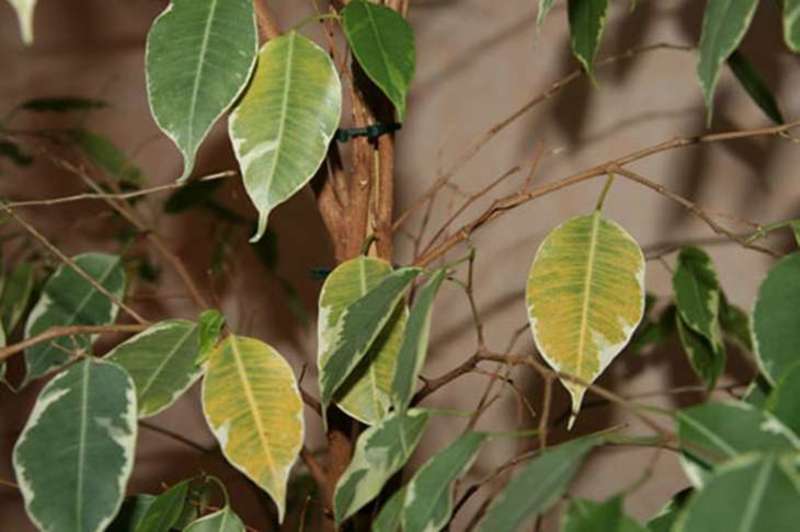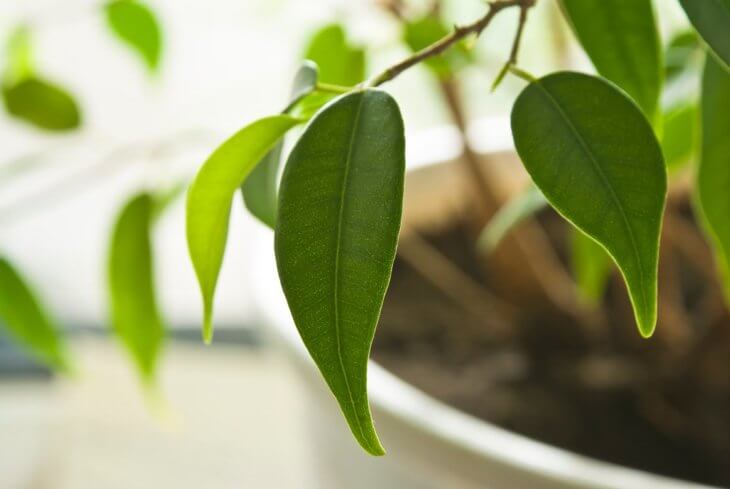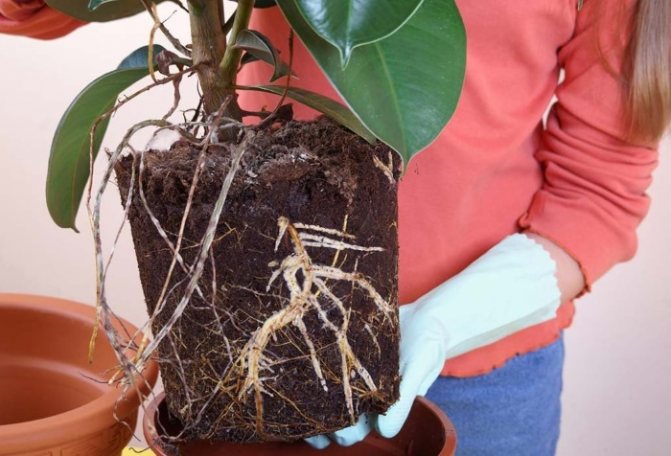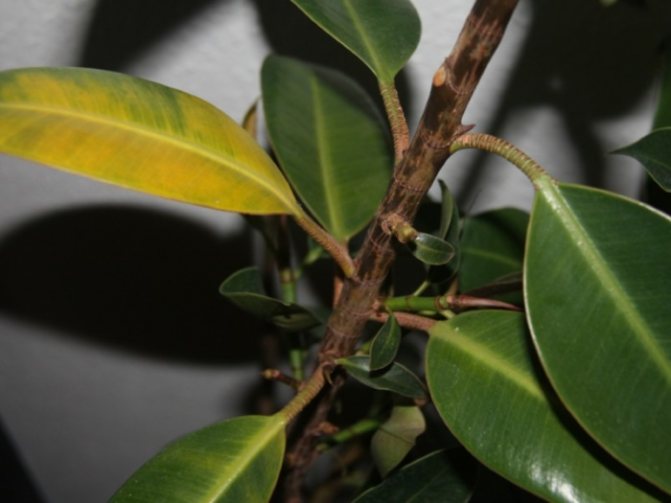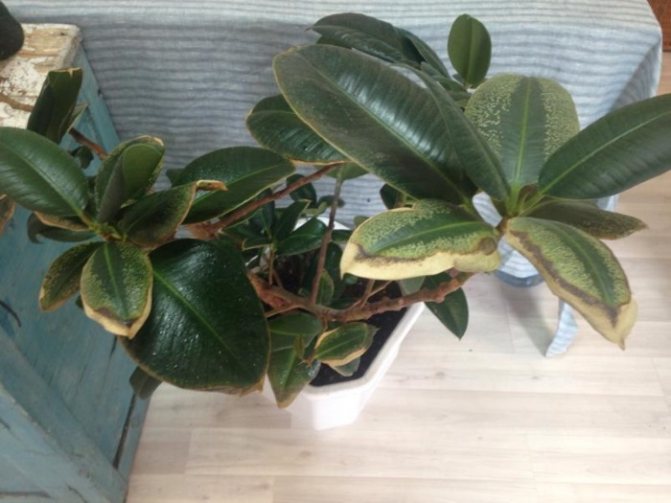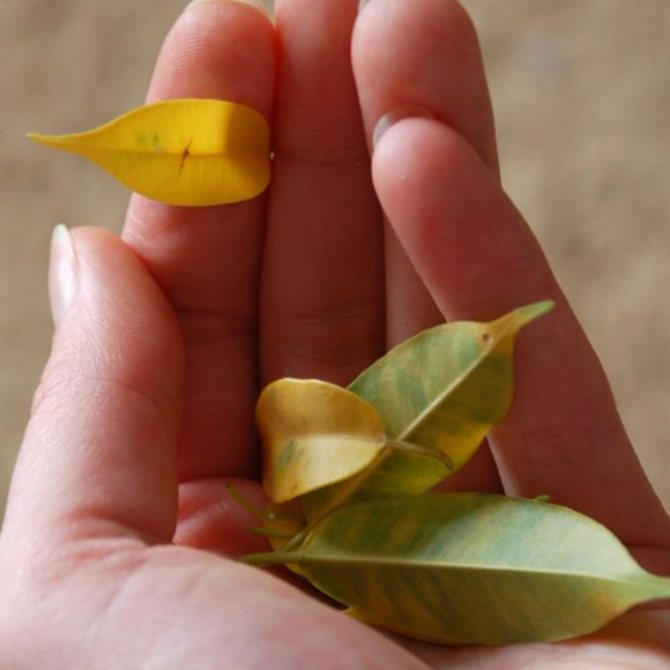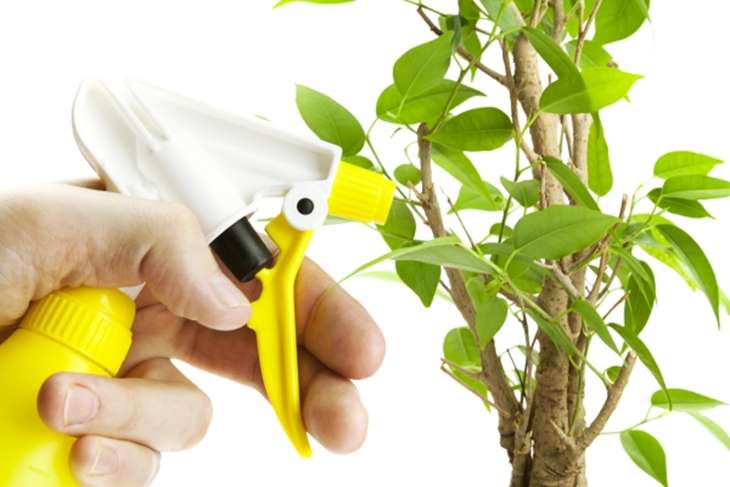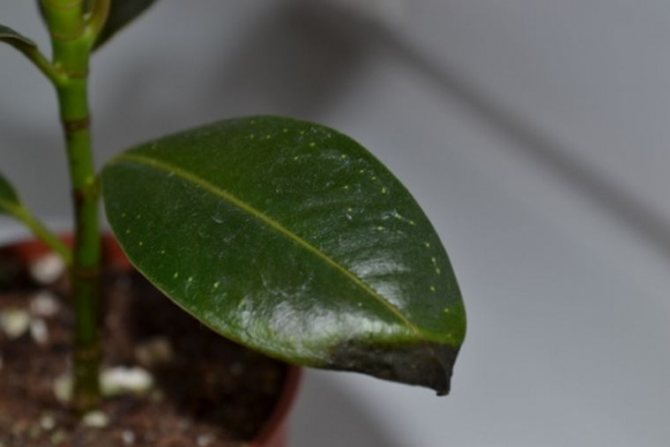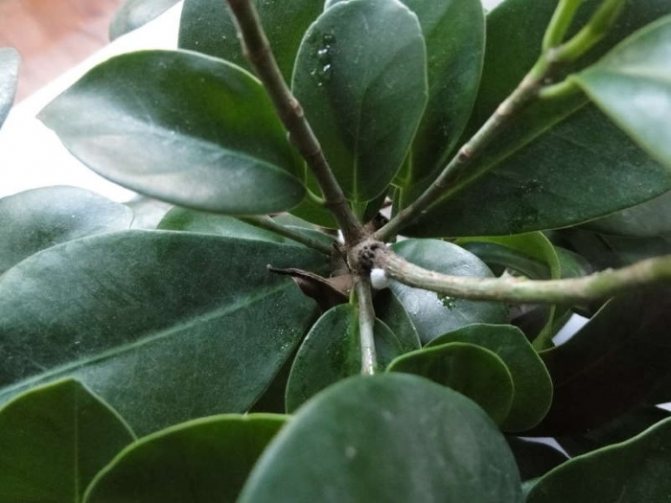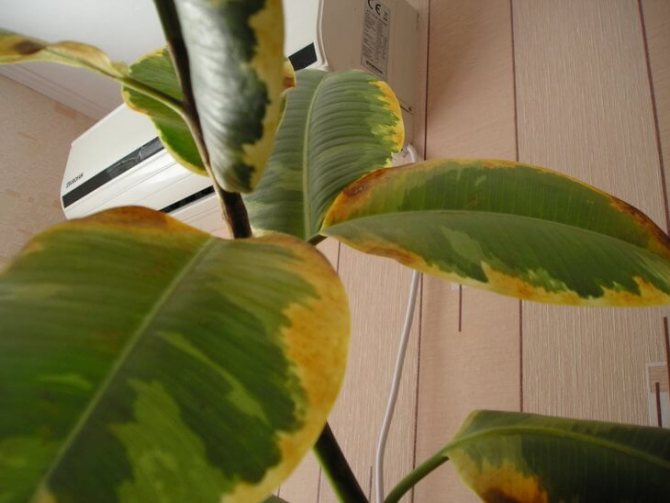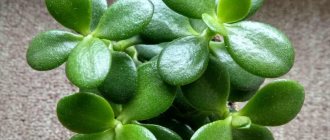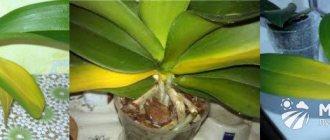Well, who said that caring for ficuses is not difficult? Even ordinary forms, under the wrong conditions, immediately react with yellowing and shedding of leaves. And how capricious are the variegated forms ...
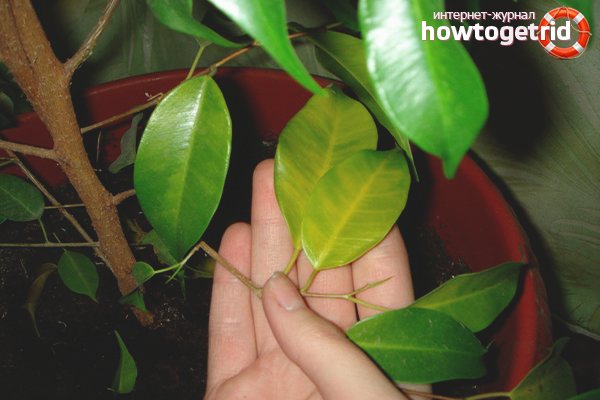
But this plant is very decorative and all efforts are paid off a hundredfold by a lush crown and exuberant growth. After reading this article, you do not have to call your acquaintances with the words: “I don’t know why the leaves of the ficus turn yellow and fall off. What to do?".
Of course, we will not be looking at the natural aging process. The loss of a few yellow leaves in the fall or winter is quite normal. We will analyze precisely the massive yellowing and the strongest leaf fall of the ficus.
Content
- Listen to the article
- Plant features
- Ficus rubber care at home How to care
- Transplant of rubber ficus
- Pruning ficus rubber
- How to form a crown
- Reproduction of rubbery ficus by cuttings
- Why is shedding leaves
Pests
Oh, those uninvited guests! Sometimes, you won't notice them right away. And the leaves of the ficus, meanwhile, gradually turn yellow and fall off. Examine the underside of the burdock carefully. It is there that entire colonies of freeloaders are often concentrated.
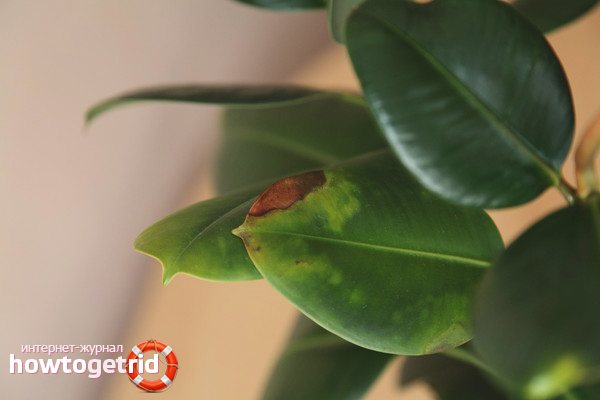

What to do? Poison mercilessly. Any systemic insecticide. And repeatedly. Most pests of indoor flowers just cannot be removed. In the meantime, grandma's infusions and decoctions from folk methods are being prepared, the ficus may die. After all, insects suck out all the nutritious juices and gnaw holes in the leaves.
Only strictly follow the instructions for use and do not exceed the dosage of the drug recommended by the manufacturer. This will not speed up the process of getting rid of pests, but it will definitely not benefit the plant.
Planting and caring for rubber ficus
- Bloom: grown as an ornamental deciduous plant.
- Lighting: bright diffused light, partial shade.
- Temperature: during the growing season - 20-25 ˚C, in winter - at least 15 ˚C.
- Watering: in the summer - 1-2 times a week, in the winter - once a week.
- Air humidity: increased. It is recommended to spray the plant in the warm season and wash its leaves with a damp sponge.
- Top dressing: from April to September, 2 times a month alternately with organic and mineral solutions with a predominance of nitrogen.
- Rest period: from October to March.
- Transfer: young ficuses are transplanted annually in spring or early summer, mature ones - once every 2-3 years. Old plants simply change the top layer of the substrate in the pot.
- Reproduction: cuttings and layering.
- Pests: aphids, nematodes, scale insects, thrips, mealybugs, yellow and red spider mites.
- Diseases: root rot, black fungus, cercospora, anthracnose, botrytis.
- Properties: ficus juice is poisonous.
Read more about the cultivation of rubber ficus below.
Ficus Benjamin leaves fall. Why does Benjamin's ficus shed its leaves?
Lack of nutrition may be the cause. The ficus has a rather capricious character, it is better to buy a special fertilizer for it.The plant should be fertilized twice a month, in spring and summer, alternating mineral and organic substances. In winter, you do not need to fertilize, at this time the plant hardly grows. Moreover, even ficus can react to complementary foods with leaf fall. If you turn it or move it from its usual place, the leaves can also turn yellow and fall off. This happens especially often in winter.
Seeing that Benjamin's ficus sheds leaves, its owner, of course, will be upset. After all, this plant is valued precisely for its lush crown. The leaves of different varieties of ficus are dark green, variegated or white, yellowish. Leaves with a clear pattern look especially elegant, for example, dark ones with a wide white stripe around the edges. The shape of the leaves resembles a drop or a boat. Their surface is smooth, and the edge can be flat or wavy. The leaves are up to 7 cm wide and up to 12 cm long.
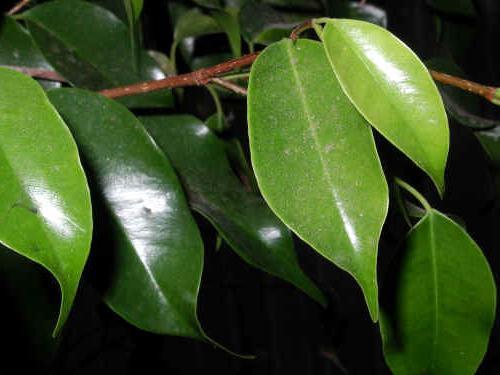

Why do leaves fall? Ficus Benjamin is an evergreen plant. But each leaf lives no more than three years. Therefore, they periodically die off. It is worth worrying if Benjamin's ficus drops leaves in large quantities. It is rather difficult to comply with all conditions of detention, so any ficus sometimes turns out to be naked. There are many possible reasons.
Ficus rubbery - features
In nature, rubber ficus sometimes grows up to 30 meters in height. It also grows in breadth due to aerial roots, which, descending from the trunk and branches of the tree to the ground, grow into the soil, supplying the plant with food and giving the tree a shape called "banyan tree". Due to the numerous winding roots in the air, the locals call this species the "snake tree".


Large leathery dark green leaves of ficus, located alternately, have an elliptical shape, pointed at the top. Young leaves are wrapped in reddish-brown stipules, which dry quickly and fall off as soon as the leaves unfold.
- How to care for Aichrizon at home (video)


The flowers of the rubber plant are not of aesthetic value, and they appear only if the plant is pollinated by certain insects, which is problematic under conditions of growing in a dwelling. Therefore, ficus can bloom only at a mature age, provided that it is grown in a spacious winter garden. Fruits are spherical syconia about 1 cm in diameter, resembling small, inedible figs.
In the recent past, the milky juice of the rubber ficus was the reason for the mass cultivation of the plant for the production of rubber. In contact with the skin, the juice can cause irritation, an allergic reaction and dermatitis, since it contains, in addition to latex, enzymes and alkaloids. But for the plant itself, sap is a means to heal wounds and cuts caused by humans or animals.
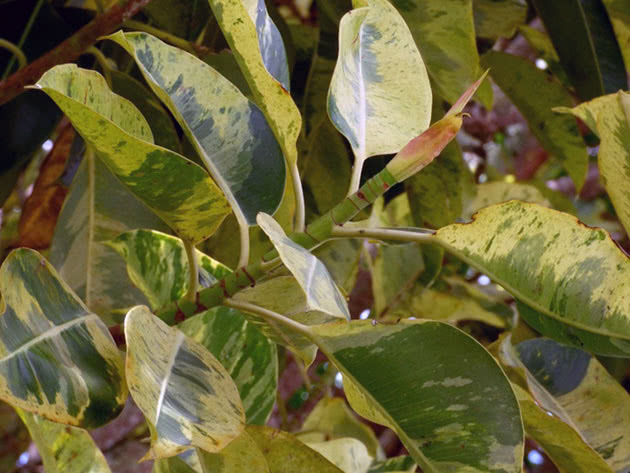

A rubber-bearing ficus at home rarely grows above two meters, but this does not mean that it grows slowly - with proper care and favorable conditions, it is able to add 40-45 cm in growth per year, and if the plant begins to rest against the ceiling, you can always trim it. The trunk of the rubber plant under the conditions of home cultivation rarely gives side shoots.
Natural causes of leaf plates falling off
Flowers, like humans, tend to experience stress. Of course, the plants will not say this, but they will show the same with their appearance. If the flower has just been bought and brought home, then there is nothing surprising in the fact that the first thing it will start to shed the leaf plates. In this case, you do not need to touch the ficus, after a while the leaf fall will stop, and the flower will begin to grow green mass.
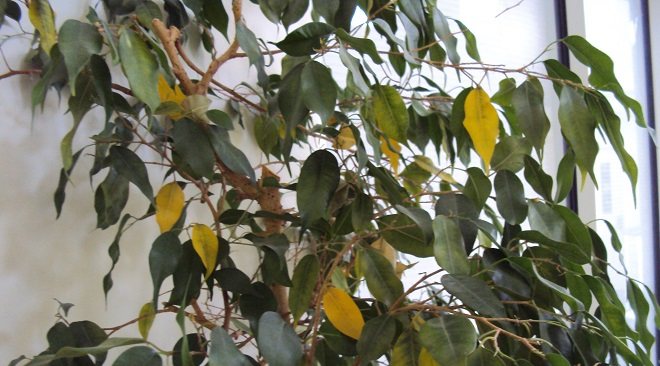

Falling foliage can occur in the autumn-winter period. In fact, ficuses are the same trees, but only small and they also tend to fall leaves before the approaching winter. Therefore, no reanimation of the flower is needed in this case.
Ficus rubber care at home
How to care for rubbery ficus
Caring for rubbery ficus is easy to organize. Ficus, like most plants, loves bright diffused light, but direct sunlight is harmful to it. Growth in partial shade is not critical for it, but in this case its growth will not be either rapid or intense, in addition, the lower leaves will soon begin to fall off. The optimum temperature for ficus rubber-bearing in the warm season is 20-25 ºC, although it can withstand a thirty-degree heat without consequences if it is not prolonged for a long time. In winter, the room where the ficus is located should be cool, but not colder than 15 ºC.


Water the ficus it is necessary when the top layer of soil in the pot dries out for a couple of fingers. Approximately: in summer - once or twice a week, in winter - once. If you overdo it with moisture, the leaves of the ficus can fall off. Air humidity in the warm season is increased by regularly spraying with water and washing the leaves with a damp sponge once every two weeks. Once a month, it would be nice to organize a warm shower for the plant, covering the soil in the pot with a film. In winter, it is better not to spray the plant, but to wipe the leaves with a damp swab and keep the rubber-bearing ficus away from heating appliances.


From April to September, for normal growth and development of rubber-bearing ficus twice a month, it is required to feed alternately with liquid mineral and organic fertilizers with a predominance of nitrogen. For example, pour a pre-moistened soil in a pot with a solution of a full teaspoon of nitrophoska in one liter of water, and two weeks later - also on wet soil - with mullein infusion. Avoid getting fertilizer on leaves and growth buds.
- Phalaenopsis at home: care (part 1)
For those who like to add shine to the already glossy leaves of rubber ficus, we recommend not using chemical compositions for this, but using non-alcoholic beer as a polish.
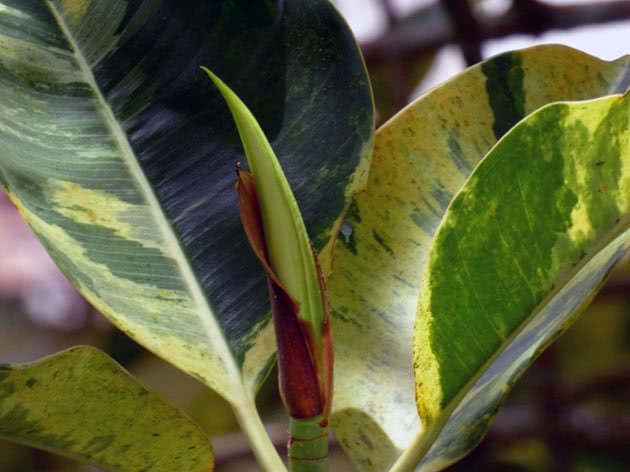

Transplant of rubber ficus
Young plants are replanted annually, and the best time for this is spring or early summer. Older plants are transplanted when the roots of the rubbery ficus fill the entire pot - every 2-3 years. The first sign that the potting medium is depleted and needs to be replaced if the water runs out too quickly into the sump when watering. Each subsequent pot for rubber ficus should be 4-5 centimeters larger in diameter and 5-6 centimeters deeper than the previous one. If the ficus is too old and worry about transplanting it can ruin it, replace the top 3 cm of the substrate with fresh every year in the pot.
The soil for home ficus should consist of equal parts of river sand, leaf, peat and turf soil. Ready-made soil for ficuses is sold in stores. You can also use a universal soil by adding a little river sand to it. How to transplant rubber ficus? Carefully removing it along with a clod of earth from the old pot and transferring it to a new one on a thick layer of drainage material. The voids are filled with fresh soil until the pot is full.
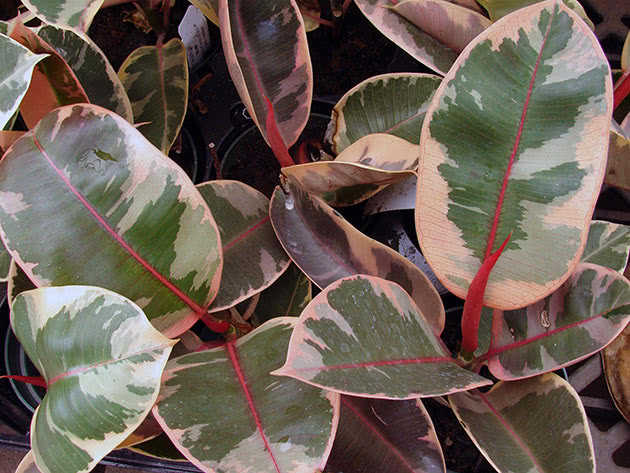

Pruning ficus rubber
Ficus pruning is done in order to contain the plant in certain dimensions that are convenient for you and for a denser growth of leaves, which eventually die off in the lower part of the trunk. How to properly prune rubber ficus? If you, wishing to provoke the growth of lateral shoots, as is usually done, cut off the top of the rubber-bearing ficus, it will not branch - at best, one of the upper buds on the trunk is activated.
The best result can be obtained by pruning five to six internodes. You can, by cutting off the top of a plant that has stretched out too quickly, root it and plant it in the same pot. Once the shoots have reached the maximum height you have determined, prune them again.Plants can be pruned only in early spring, otherwise the lateral buds that have not awakened will go into growth, but again the highest point of growth. Pruning is done with a sharp, sterile blade. The milky juice released during this is washed off with water.


How to form the crown of rubber ficus
If you want the ficus to grow as a lush bush, plant several plants in one pot and keep the pot in partial shade, turning it from time to time around its axis so that the ficus shoots do not stretch in one direction - to the light source. If you have one plant in a pot, and you do not know how to form a beautiful crown of a rubbery ficus from a single stem, try to provoke the growth of lateral shoots by pruning, as described in the previous section.
The formation of a rubbery ficus can also be carried out by piercing the trunk to a depth of one third of its thickness, and such stimulation should be started from the upper part of the trunk, and then gradually pierce the trunk below. You can also use this method: the top of a young flexible ficus is tilted down as far as possible and fixed in this position. The bud, which turned out to be higher than all the others, starts to grow, and after that you can return the stem to its normal position.
- Photo of hibiscus with species names


Diseases
They just don't show up. They arise from hypothermia of the root system, are transmitted from other infected plants, and are transferred with purchased soil. It is difficult to miss the signs of the disease. On the leaves, in addition to yellowness, brown spots of unknown etiology appear. They grow rapidly, turning into weeping ulcers of a purple hue.
What to do? Save your pet immediately. Periodic spraying with any fungicide often corrects the situation and very quickly. In advanced cases, it is sometimes too late. In this case, you need to cut the cuttings from the remaining shoots and try to root them.
No doubt, the adult plant is a pity. But instead of him there will be several young ones.
By the way, it is recommended to use adaptogens for a quick recovery of slightly affected ficus. Epin, aloe juice or zircon very well activate the vitality of the plant and allow it to grow stronger and recover from disease faster.
Why do ficus leaves turn yellow and fall off? What to do? We know for sure. A capricious plant needs constant and proper care. Otherwise, your once lush bush may turn into a palm tree with a bunch on top of its head. Or worse, it will become an ikebana. Love your plants and take care of them.
why do the leaves of orchids turn yellow
Reproduction of rubber ficus
Reproduction of rubbery ficus by cuttings
Cutting rubber-bearing ficus is one of the most reliable methods of its reproduction. How to root rubber ficus? The stem or apical stalk 10-15 cm long is cut obliquely, the leaves are removed from it, leaving only one or two upper leaves, kept under running water until the milky juice ceases to stand out, and placed in water for growing roots. Roll the leaves remaining on the handle into a tube to reduce the evaporation area, and fix them in this position with an elastic band. But it is better to root the stalk of rubber ficus in the ground by pulling a transparent plastic bag on top.
Rooting of varieties with green leaves goes without problems, but it is better to treat the lower cut of cuttings of variegated varieties with root or heteroauxin before planting in the ground, subsequently applying lower heating of the greenhouse, although this does not guarantee the rooting of cuttings of variegated forms of rubber ficus.


Reproduction of rubbery ficus by layering
How can you propagate rubber ficus with variegated leaf color? Air layering. To do this, an incision is made on the trunk of the ficus to a depth of one third of the thickness of the trunk, into which a match is inserted to avoid closing the edges of the incision.This part of the trunk is wrapped with wet sphagnum moss, then with polyethylene for tightness, which is fixed on the trunk with tape. As soon as you see through the transparent film that the ficus has formed roots, cut the shoot below the cut with the roots and plant it in the ground.
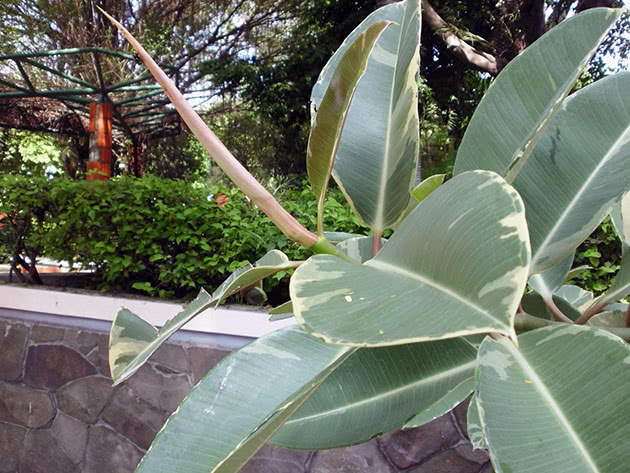

Reproduction of rubbery ficus with a leaf
This type of reproduction exists only in other people's stories. That is, if a ficus rubber leaf is put into water, it will most likely give roots, but this, believe me, is all that it is capable of. Even if you plant it in the ground and take care of it like a king, the most you will wait for is a pot filled with roots, but the leaf will not sprout. Alas.
Lack of micronutrients
Often, flower growers seem to dance with a tambourine near a ficus and whatever they do, and he, such a scoundrel, again gives you his yellow leaves every morning. What is he still missing? And he lacks food. Magnesium, iron and nitrogen - these are the trace elements that prevent premature aging and yellowing of the leaves.
What to do? Feed. Green liquid fertilizer is good, but it only provides nitrogen. And the ficus needs a mineral water. Top dressing is applied regularly, but little by little. Overkill threatens the same result as undersupply.
If you are not a supporter of the use of chemical fertilizers, then give your ficus to a person with the opposite worldview, and buy yourself an artificial one. It will definitely not turn yellow.
Pests and diseases of rubber ficus
The rubbery ficus is quite resistant to pests and diseases, but sometimes it has problems due to the invasion of scale insects or spider mites, which can be fought by washing the leaves with an infusion of tobacco dust (4 tablespoons per liter of water) with the addition of soap and then washing off this solution with leaves after two hours. In case of damage by scabbards, try to remove all shields from the leaves with a swab. And remember: clean leaves are the key to the health and invulnerability of the ficus.
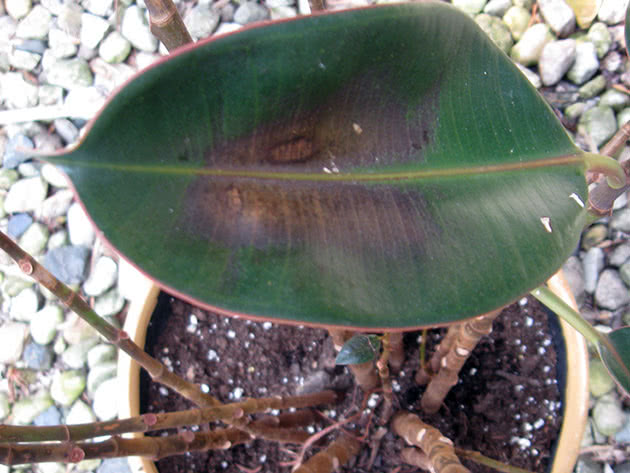

Rubbery ficus sheds leaves
If only the lower leaves of a rubbery ficus fall off, then this is a natural process for any plant. But if not only old leaves fall, then there may be several reasons:
- excessive soil moisture;
- overdried earthen lump;
- cold draft or sudden temperature drop;
- bad light.
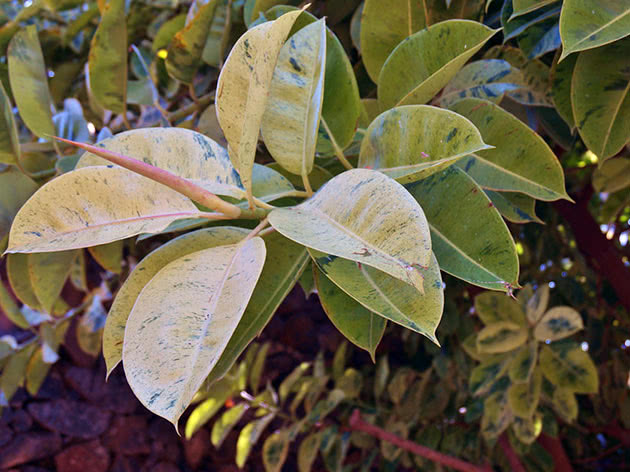

The leaves of the rubbery ficus turn yellow
Why does rubber-bearing ficus turn yellow? Because the conditions of his detention and the rules of care have been violated. Actually, usually the leaves first turn yellow and then fall off, and the reasons for the sudden leaf fall are indicated in the previous section. But there are other factors that cause the plant to change the color of the leaves:
- excess fertilizer in the soil - this can be corrected by rinsing the substrate through overhead irrigation with an amount of water equal to three times the volume of the pot with ficus. After this procedure, do not feed the plant for two months;
- too much salt in the substrate. In this case, only transplanting the plant into a new soil will save;
- a pot too large for a plant - transplant the plant into a smaller container;
- rotting of the root system - if the soil smells of rot, you will have to remove the plant from the pot, remove the rotten roots and transplant it into fresh soil. If it's not too late.
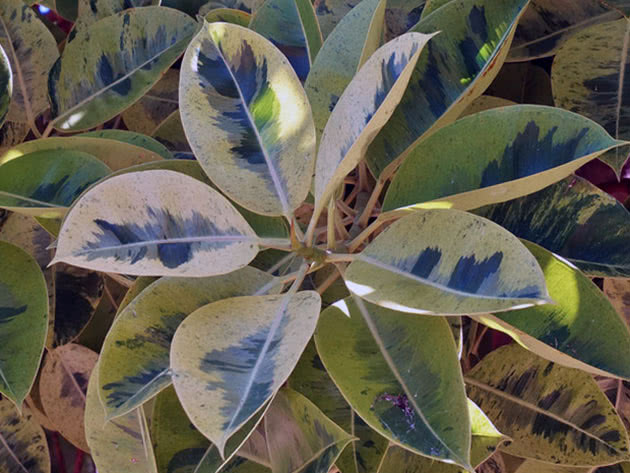

Ficus rubbery does not grow
There may be three reasons: there is not enough light for the ficus, not enough food, or the pot has become too small for it. Correct the mistakes, and it will start to grow by leaps and bounds.
Cold
In general, many problems are very clearly manifested in ficuses precisely by the yellowing of the leaves. And to dump their plant as passion as it loves! Do not feed bread, let the leaves fall.
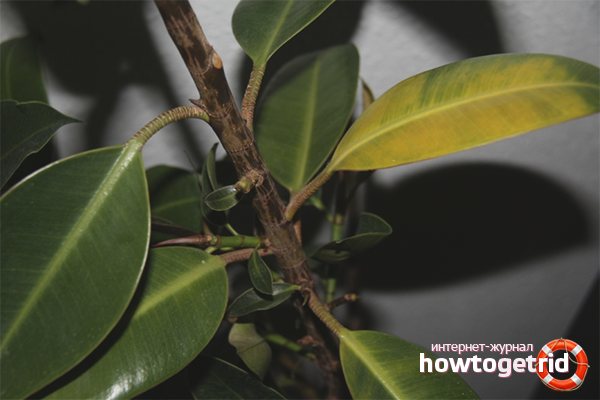

For example, cold ambient air, the slightest draft, cooling of the root system. Or in winter, a leaf touches the glass, lo and behold, and it is already turning yellow.
What to do? Protect the ficus from the cold in every possible way.Under the legs, they put a plate of foam plastic, foam insulation or even a cork stand. Even an ordinary board will do.
Protect him from drafts. They ventilate well, but make sure that the cold air does not draw. In winter, an insulator is moved away from the glass or even placed. It could even be a simple piece of woolen cloth or a piece of cardboard.
The water for irrigation also should not be cold from the tap immediately or from a well. Room temperature will be optimal for drinking ficus. And it certainly will not overcool the roots.
Botrytis or gray rot
This disease appears on those plants that are in hot, unventilated rooms with high levels of humidity. Lack of drainage in the soil is another cause of this disease.
The disease manifests itself as follows: a gray tint appears on the stem and leaves, if the plant is shaken, then dust will fly from it. Then the leaves begin to curl, darken, dry up and fall off. If you do not take action, the ficus will quickly die. What to do?
- Remove all damaged areas of the plant, wipe the rest with a solution: a glass of wood ash and chalk, a teaspoon of copper sulfate in a bucket of water. This is with a mild defeat. If it is strong, a fungicide is required, for example, "Fitosporin-M".
- Ventilate the room stably, do not allow stagnation of humid air.
- Stabilize watering.
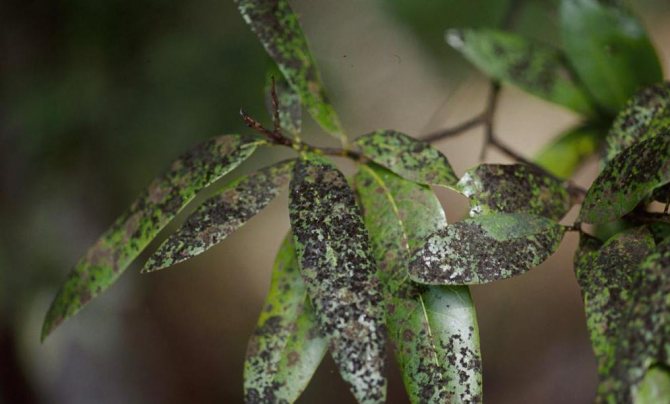

Sooty mushroom
Do ficus leaves curl? Most likely, he was struck by a sooty mushroom. The disease is also manifested by the presence of black bloom on the foliage of the plant. Insects are the culprit of infection (more precisely, their allocation). How to treat ficus leaves?
- Severely affected foliage must be removed and destroyed. Treat all other areas (not affected or slightly affected) with a strong soap solution (preferably using real laundry soap).
- The stem and root system of the ficus must be treated with fungicides.
Hypothermia
Ficus grows naturally in southern countries, therefore it is very sensitive to cold. In conditions of low temperature or frequent drafts, the flower catches a cold and reacts to this by dropping, yellowing of the foliage.
What to do
Place the plant in a warm area and protect it from drafts when ventilated. If the ficus is on the windowsill, make sure that the leaves of the glasses do not touch in winter. When the pot is on a cold floor, place a support under it to avoid hypothermia of the roots.
Houseplants Directory
Ficus with yellow leaves. Why do ficus leaves turn yellow? Ficus problems - diseased leaves. Read in today's article why the leaves turned yellow and how to cure ficus at home?
Why do the lower leaves of the ficus turn yellow?
Excluding natural causeswhy the lower leaves of the ficus turn yellow, consider the features of the microclimate that affect the state of the plant.
- 3-year-old ficus partially sheds its leaves, the leaves turn yellow.
Why do the lower leaves of the ficus turn yellow:
- Rearranged.
- Placed in a draft.
- Waterlogged.
- Long stood in the sun.
Ficus does not like change and you will have to put up with this - if you rearrange the plant, then it will quickly turn yellow or shed its leaves, especially when the new place is uncomfortable. Yellowing can begin both from the lower areas, and chaotically: lateral, central, partially upper or group yellowing, etc.


What to do: move the ficus to its original place, if the plant was comfortable there; choose a new place for the ficus.
How to quickly restore: with moderate watering, suitable placement - after 2 weeks.
Basic ficus care and placement:
- Air temperature + 19-21 ° С.
- Diffuse, continuous lighting.
- Located away from batteries, heaters.
Excess minerals


Not only a deficiency of fertilizers can cause problems with leaves, but also an excess of them: the state of overfeeding is no less harmful for the ficus.In the case of an excess of fertilizers, the flower not only turns yellow, its stems also begin to blacken, then darkens and becomes covered with brown spots of foliage.
What to do
If the plant is damaged due to too abundant "feeding", temporarily stop fertilizing. If the overfeeding is too strong and the roots are burned, you will have to urgently transplant the flower before it dies.
Spider mite
This is the enemy of most plants, and it can really kill your green friend if you don't take action in time. Brown and gray spots appear on the leaf, a thin cobweb is stretched between the leaves. If you look closely, you can see the bustle of small insects - spider mites. The reason for the appearance of these pests is heat and dry air. How to fight?
Treat the plant with an insecticide, then be sure to transplant. The pot must be fresh, the soil must be roasted. Place the pot in a different place, as the old one (in the smallest crevices) may contain spider mite eggs, which remain vital for up to three years. Treat the surface and corners with insecticide.
Prevention: maintaining the optimal temperature in the room, humidifying the air. Any land before transplanting plants must be fried or watered with potassium permanganate.
Temperature regime
In small-leaved ficus, leaves crumble if it is not provided with sufficient protection from cold air currents. This feature should be taken into account when choosing a place to install the pot. When ventilating the room, it must be securely closed from drafts. Leaves should not touch glass, especially in winter. A wooden board or foam tile is placed on the linoleum under the pot.
It is important to protect a miniature variety of ficus - microcarp bonsai from hypothermia. The most suitable air temperature for it varies from 24 to 30 degrees. Irrigation water should be at room temperature. The pot should not be placed in a sunny place in the southern part of the room, as overheating of the leaves can lead to their drying out and loss. They choose a place so that in winter the flower is not near the battery.
Shield
Do ficus have dots on the leaves? If these are convex small dots on the back of the leaf, which have appeared on some parts of the stem, then this is a scale parasite that feeds on the sap of the plant, and it gradually begins to die.
The scabbard leaves behind a discharge, and this is the soil for the development of a sooty fungus, which has already been described above. What to do? How to get rid of the parasite?


- Rinse the foliage and stem well with soapy water.
- Dry, carry out processing with "Aktellikom".
- The procedure is repeated three times every seven days.
The consequences of improper care
With improper care, not only yellow spots appear, but the entire plant suffers completely. Improper watering is one of the main reasons for the appearance of yellowness. Ficuses do not like heavy watering. It is worth moistening the soil as soon as it is completely dry.
Advice! To determine the dryness of the soil, stick a stick into the soil. If you take it out, it will be dry, which means time for watering.
If yellow spots appear on the ficus, it is worth limiting watering for two weeks. In the case when the flower dries and withers, it is necessary to transplant to a new place. Remove any roots that have begun to rot before planting.
Important! When watering soft water, a white crust appears on the soil surface and on the underside of the flowerpot.
The lack of trace elements affects the flower, it begins to dry out and may die. For the plant to develop properly, a sufficient amount of nutrients in the soil is necessary. Deficiency leads to metabolic disorders, the plant develops poorly, the shape of the flower changes, the color of the leaf.


Micronutrient deficiency symptoms:
- the plant sheds foliage prematurely, especially the lower tier;
- too fragile stems;
- poorly developed root system;
- the appearance of pale and yellow spots on the leaf.
An overabundance of minerals entails various problems:
- poor flower development, especially in summer;
- the leafy plate dries along the edges, cinnamon spots appear;
- the stems are fragile and brittle;
- the leaves begin to wither.
Transfer
Ficuses are still touchy. They really do not like to be disturbed. Even a simple change of residence is fraught with yellowing and leaf fall. And then the whole event! A transplant is always stressful. After her, the ficus will definitely turn yellow and throw leaves.
Read also: Who is harmful to eat tomatoes
What to do? Try to touch the flower as little as possible. The transplant should not be carried out annually, as some sources recommend, but only as needed. For example, when the roots begin to rise above the soil surface in a pot. At the same time, it is advisable not to gut the earthen lump, but only to transfer it entirely into a large container. Then the gaps are filled with new soil, pressed with hands.
It is important to know that after transplanting it is strictly forbidden to water the ficus! Therefore, they fill up the new earth in a wet state. Then the flower is returned to its original place in the same position in relation to the light, as it was before. After about 8-9 days, you can gently water the ficus for the first time. Well, then leaving and only leaving.
How to prevent yellow leaves
Remember the dangers of over-watering: excess moisture in the soil can cause fungus to appear. To prevent the leaves from losing their rich green color, protect them from direct sunlight and drafts, which, even in summer, can damage a plant that is sensitive to heat and temperature changes.
Did you know? In India, bridges over ravines and shallow rivers are grown from the roots of a certain type of ficus. Roots are attached to bamboo sticks, which gradually grow to the opposite bank. Such "living" bridges are very strong and durable. The oldest bridge, according to scientists, is about 500 years old
.
Nematodes
Outwardly, the disease is manifested only by yellowing and falling foliage, the very reason for this lies in the roots. Nematodes are small spherical growths on the roots of a ficus that secrete toxins, they poison the plant, leading to a slow and painful death.
Control methods:
- Remove the ficus from the pot, which can be disposed of immediately along with the soil.
- Rinse the roots, then leave them to soak in insecticide for three hours.
- Plant the ficus plant in new, oven-roasted soil.
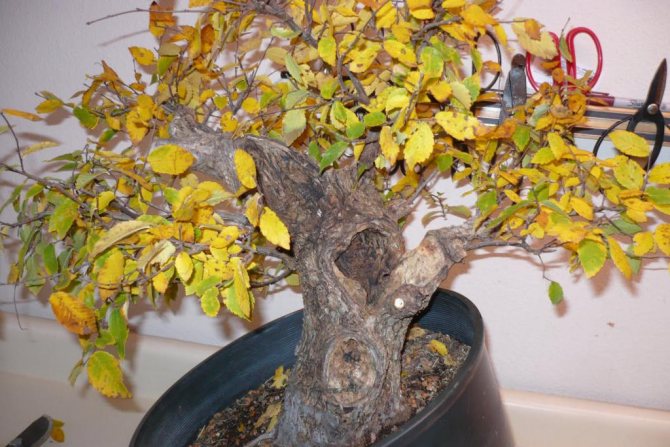

Rescue measures
The rapid yellowing of the foliage provokes its fall, which has a detrimental effect on the plant and ends with its death.
The initial stage in the treatment of a sick ficus is pruning yellowed leaves. All yellow parts are removed, the cut sites are treated with charcoal or activated carbon.
Further rescue actions are chosen depending on the reason.
Pests
When the ficus is damaged by harmful insects, spraying with insecticidal preparations is carried out.
Additionally, the leaf plates are wiped with soapy water or the plant is sprayed with it for 2 weeks (50 g of crushed laundry soap per 1 water).
If the soil is contaminated, it must be replaced. Before transplantation, diseased fragments are cut off at the roots, followed by processing of healthy tissues with a weak solution of potassium permanganate for disinfection.
Diseases
It is advisable to treat a flower culture from fungal infections when the infection is not extensive and has not affected 2/3 of the root system area. With a massive defeat, it is not possible to save an indoor flower: it is thrown away.
Violation of care
If the basic rules of care are violated, first of all, they create a favorable microclimate and make up for the lack of nutrition:
- the frequency of watering is set depending on the drying of the surface layer by 2-5 cm, increasing in summer and reducing in winter;
- a flooded flower requires transplantation into a fresh substrate;
- top dressing with nitrogen-containing fertilizers in spring and potassium-phosphorus fertilizers in autumn is applied at intervals of 2 weeks; dolomite flour, urea, potassium magnesium sulfate, magnesium sulfate can be applied;
- a plant whose roots are frozen is placed in a warm place and watered with a small amount of warm, but not hot, water.
Irrigation mode
If yellow markings appear on the leaf blades that increase and spread over the entire surface, then excessive watering may be the cause. Constant stagnation of moisture causes gradual decay and death of the roots. An unpleasant odor spreads from the flower pot.
Yellow spots on ficus leaves
On the cuts of rubbery ficus, not milky viscous juice is released, but a brownish liquid. Having noticed the first signs, you can try to save the plant by organizing the correct irrigation regime. He needs water when the earthen lump becomes dry. An hour after watering, the pallet is checked. If excess liquid has seeped into it, it is removed.
With a massive drop of foliage, you will have to check the root system. Moisten the soil in the pot, carefully remove the flower, shake it off and wash the roots. With a sharp knife treated in alcohol, they cut off the rotten processes, pouring powdered activated carbon onto the sections.
The pot is cleaned using a solution of potassium permanganate ("potassium permanganate"), a drainage layer and a fresh soil mixture are laid. Ficus is planted, carefully compacting the earth around the roots. Moisten the soil and place the plant immediately in the chosen permanent place, which cannot be reached by direct sunlight.
In the winter season, when the heating is on, the air in the room becomes dry. Such an atmosphere is not considered favorable for ficus. Yellowness appears on the tips and sides of the leaf plates. Then these areas become thinner and dry, and the leaf gradually dies off completely. As a preventive measure, regular spraying of the crown is used. You can put a humidifier or a container of water next to it.
How to identify the problem?
In ficus, subject to all the necessary growing conditions, a natural yellowing of the leaves can be observed, which then fall off. This happens in late autumn, when the plant prepares for the onset of the dormant period. Ficus Benjamin painlessly parts with part of the foliage in winter. If in these seasons the flower has lost no more than ten leaf plates, then there is no reason for concern, since in the spring the splendor of the crown will be restored.
Having discovered in the summer that the ficus is actively shedding foliage, you should immediately examine the plant to determine the cause. This may be non-compliance with the rules of care, the appearance of pests or the development of diseases.
The most popular and demanded
More than 2000 species of ficus grow in the wild, only a few of them are considered decorative:
- Rough;
- Banyan tree;
- Variegated;
- Parcel;
- Sacred;
- Triangular;
- Ivy;
- Montana;
- Rooting;
- Karika;
- Rusty;
- Benjamin;
- Creeping;
- Retuza;
- Lyre-shaped;
- Dwarf;
- Rubbery.
Each type of ficus needs special care and attention, but almost all varieties need approximately the same conditions for normal growth and a beautiful appearance.

